|
|
 |
"My work has been influenced by abstract biomorphic
sculpture originally created by the 20th century Surrealists. A
biomorph is a non-representational form or pattern that resembles a
living organism, either plant or animal, in shape or appearance.
“Bio” comes from the Greek word for “living being” and “morph” from
the Greek word meaning “form.” In the 1990’s the subject of my
biomorphic work often alluded to the ideas of hybridization and
“weird science” Since then, my work, while still informed by organic
abstraction and issues of biological manipulation, contain more
elements from my daily life and reflect the importance of place in
providing inspiration.
In this work, rather than creating forms that are
based on scientific fantasy, I am synthesizing and abstracting
various elements from around me. These elements then lead to the
creation of new forms, which seem to have an animate presence. Some
contributing elements are living beings, such as the birds and
rabbits in the woods behind my house, while other elements are the
inanimate decorative buildings and architectural elements in my new
city. The surface of the work reflects my love of mark making and
patterning, and I think of these surfaces as the “skin” of the
bimorphs. This surface patterning also reflects my love of the
decorative, and it acknowledges the influence of the Pattern and
Decoration Movement of the 1970’s.
Jean Arp, who began as a surrealist sculptor, shared
with many artists of his time the inclination toward not wanting “to
copy nature” i.e., produce realistic still life, landscapes, or
figures. The abstract impulse in the art of Arp’s time was, as he
said, a “wish to not reproduce but to produce”…. to
create something from ones’ own unique experiences. This wish to
produce rather than reproduce is an impulse I share in this work.
The slow process of using clay coils to build a form and the slow
surface techniques I use-- slip trailing, sgraffito, and inlay,
allow me time to reflect and invent and to dialogue with the piece.
I think my earlier career as a potter and my
exploration of the vessel is also evident in these forms. I was
always drawn to vessel shapes, particularly bottle forms, baskets,
and vase forms with handles. In truth I never really cared about
their function so much, but I loved the sinuous curve, the shapes of
the negative space, and the manner in which pots were
anthropomorphized. In pottery lingo, pots have lips, feet,
shoulders, bellies and necks. The nature of a vessel is that of
containing, nurturing, and carrying out various domestic functions;
activities that carry social and cultural significance. In this
work, I have sealed, altered and re-contextualized the vessel,
creating a sculptural object that is both referential and
conceptual." - Melody Evans
 |
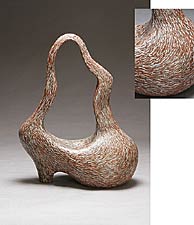
Rabbit's Foot
Ceramic, Glaze, 2007
22" x 26" x 12"
|
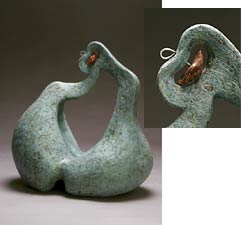
Playing with Stones (at the American River)
Ceramic, Glaze, 2007
23" x 21" x 13"
|
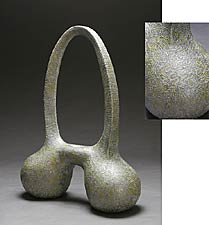
Mid West Road Trip
Ceramic, Glaze, Metallic, 2007
28˝" x 24" x 11"
|
 |
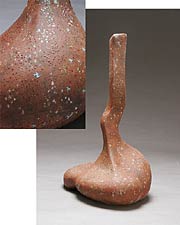
Celestial Body
Ceramic, Glaze, 2007
27" x 17" x 14"
|
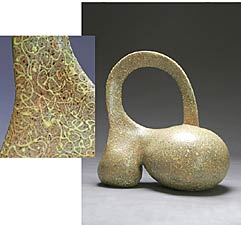
Big Bend
Ceramic, 2007
19" x 19" x 12"
|
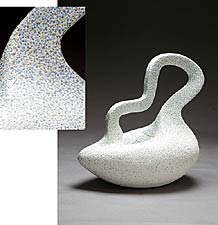
Key West
Ceramic, Glaze, 2007
20" x 21" x 13"
|
 |
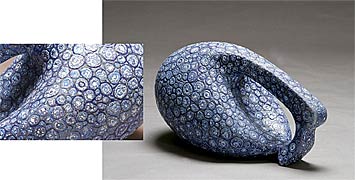
Baltimore
Ceramic, Glaze, 2007
17" x 6" x 11"
|
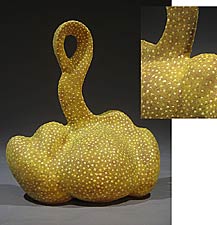
O Yaku
Ceramic, Glaze, 2007
21" x 19" x 13"
|
 |
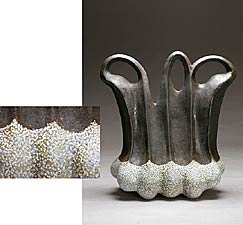
Egg Basket
Ceramic, Glaze, 2007
22" x 19" x 11"
|
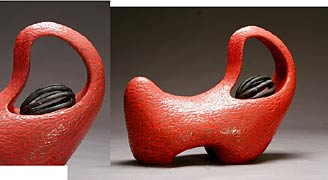
Meow
Ceramic, Glaze, 2007
25" x 19" x 12"
|
 |

BB2
Ceramic, Glaze, 2007
16" x 9" x 9"
|

 |
|